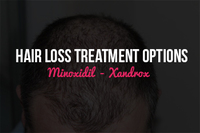Hair Loss Treatment Options
23rd Jun 2014
 Anyone who is losing hair has plenty of treatment options to choose from. The most popular is Rogaine, also known as Minoxidil as this is its active ingredient. Rogaine is the only Federal Drug Administration approved pattern baldness treatment on the market aside from Propecia. Rogaine is applied directly onto the section of the scalp that is losing hair. The patient merely dabs the solution onto his fingers and rubs it into his scalp. Not only can Rogaine slow the rate at which hair is lost, it can also promote the actual growth of hair. Propecia is a pill that must be prescribed by a doctor. This is also an effective treatment option yet it must be taken continuously without any gaps. If the patient skips a day here and there then he likely won't slow his hair loss or grow new hair.
Anyone who is losing hair has plenty of treatment options to choose from. The most popular is Rogaine, also known as Minoxidil as this is its active ingredient. Rogaine is the only Federal Drug Administration approved pattern baldness treatment on the market aside from Propecia. Rogaine is applied directly onto the section of the scalp that is losing hair. The patient merely dabs the solution onto his fingers and rubs it into his scalp. Not only can Rogaine slow the rate at which hair is lost, it can also promote the actual growth of hair. Propecia is a pill that must be prescribed by a doctor. This is also an effective treatment option yet it must be taken continuously without any gaps. If the patient skips a day here and there then he likely won't slow his hair loss or grow new hair.
Aside from Minoxidil / Rogaine and Propecia, other hair loss solutions include a multitude of hair transplants. These include punch grafting, mini grafting, strip grafting, micro grafting and slit grafting. Grafting is an outpatient procedure that is typically performed in a dermatological surgeon's work space. The surgeon applies a local anesthetic by way of an injection into the scalp. Some patients will have sedation administered in order to achieve the maximum comfort. Micro grafting involves between one and two hairs per graft. Mini grafting utilizes two to four hairs per graft. Slit grafting has four to ten hairs per graft. Punch grafting has ten to fifteen hairs per graft. Strip grafting involves very long and slender grafts that each have thirty to forty hairs. Patients must consult with a doctor to determine whether a grafting method is appropriate for their unique situations. Each patient's circumstances and hair goals will help his doctor determine which method is best for him.
 Scalp reduction is also a means to transplant hair. This involves the removal of skin on the scalp that does not contain hair in order to allow the skin that does have hair to be stretched to cover the bald portions. Scalp reductions typically eliminate half of the scalp's bald areas on both the top of the head and the back of the head. Scalp reductions are not applicable to the front section of the head. Scalp reductions also require an injection of a local anesthetic so that the bald portion of the scalp can be removed without causing pain to the patient. Stitches are required when the skin around this area is stretched so that the portions of the scalp with hair can be combined.
Scalp reduction is also a means to transplant hair. This involves the removal of skin on the scalp that does not contain hair in order to allow the skin that does have hair to be stretched to cover the bald portions. Scalp reductions typically eliminate half of the scalp's bald areas on both the top of the head and the back of the head. Scalp reductions are not applicable to the front section of the head. Scalp reductions also require an injection of a local anesthetic so that the bald portion of the scalp can be removed without causing pain to the patient. Stitches are required when the skin around this area is stretched so that the portions of the scalp with hair can be combined.
Most patients prefer to take Minoxidil or Propecia as they aren't painful. There is some pain felt after scalp reduction surgery as well as grafting procedures. These include scalp tightness, general aches and pains and headaches.

